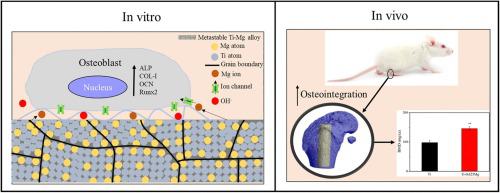Colloids and Surfaces B: Biointerfaces ( IF 5.8 ) Pub Date : 2020-09-18 , DOI: 10.1016/j.colsurfb.2020.111360 Luxin Liang 1 , Qianli Huang 1 , Hong Wu 1 , Zhengxiao Ouyang 2 , Tang Liu 2 , Hao He 3 , Jian Xiao 4 , Guanghua Lei 5 , Kun Zhou 6

|
Magnesium (Mg) is well-known for its bioactivity and degradability. However, due to its low evaporation temperature and limited solubility in titanium (Ti), the fabrication of Ti-Mg composite materials remains a huge challenge. In this study, Ti-xMg (x = 0.312, 0.625, 1.25 and 2.5 wt.%) composite materials were fabricated by the combination of mechanical alloying (MA) and spark plasma sintering (SPS). Mg mainly exists as a solid solute element in the Ti matrix, while a part of it re-precipitated into the Ti matrix during the SPS process. At a low content of 0.625 wt.%, Mg could increase the mechanical strength of Ti by the co-strengthening effects of solid solution and precipitation. However, it was detrimental to material mechanical properties when its content increased to 1.25 wt.%. Being immersed in phosphate buffered solution (PBS), Ti-Mg composite materials exhibited a burst Mg2+ release behavior within the first day, and then the rates of Mg2+ release gradually decreased within the following 27 days. The results suggested that the cell viability was dependent on the content of Mg in Ti-Mg composites. The high content of the Mg (2.5 wt.%) in the Ti-Mg composite could lead to significant cytotoxicity. However, appropriate Mg content (0.312∼0.625 wt.%) could promote cell attachment, proliferation and differentiation. The Ti-0.625Mg group exhibited the best in vitro biological performance among all groups. In vivo results obtained by implanting Ti-0.625Mg composite in the femurs of rats further revealed its enhanced regenerative potential and osteointegration compared to pure Ti implant.
中文翻译:

具有镁离子缓释功能的Ti-Mg复合材料刺激体外和体内成骨
镁(Mg)以其生物活性和可降解性而闻名。然而,由于其低的蒸发温度和在钛(Ti)中的溶解度有限,Ti-Mg复合材料的制造仍然是巨大的挑战。在这项研究中,Ti-xMg(x = 0.312、0.625、1.25和2.5 wt。%)复合材料是通过机械合金化(MA)和火花等离子体烧结(SPS)的组合制成的。Mg主要以固体溶质元素的形式存在于Ti基体中,而一部分在SPS过程中会重新沉淀到Ti基体中。在0.625 wt。%的低含量下,Mg可以通过固溶和沉淀的共同强化作用来提高Ti的机械强度。然而,当其含量增加到1.25wt。%时,它不利于材料的机械性能。浸入磷酸盐缓冲液(PBS)中,2+在第一天的释放行为,然后在接下来的27天内Mg 2+的释放速率逐渐降低。结果表明,细胞活力取决于Ti-Mg复合材料中Mg的含量。Ti-Mg复合材料中高含量的Mg(2.5 wt。%)可能导致明显的细胞毒性。但是,适当的镁含量(0.312〜0.625 wt。%)可以促进细胞附着,增殖和分化。Ti-0.625Mg组在所有组中均表现出最佳的体外生物学性能。通过在大鼠股骨中植入Ti-0.625Mg复合材料而获得的体内结果进一步表明,与纯Ti植入物相比,它具有更高的再生潜力和骨整合能力。



























 京公网安备 11010802027423号
京公网安备 11010802027423号